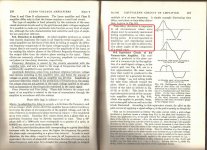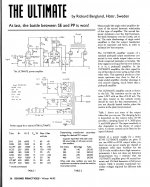I agree with jhstewart. Design goal should be lowering all harmonics as much as possible
Thanks sser2 and jhstewart, well noted your contribution as well.
Having heard good amps with monotonically decreasing harmonic, I would disagree. The decreasing harmonic structure sounds cleaner than some lower overall THD. Low distortion is good, but THD doesn't closely relate to how we hear. The ear isn't that simple.Design goal should be lowering all harmonics as much as possible, not trying to concoct a perfect cocktail of different harmonics
Probably works for you because you use ESL or multiway. Users of single dynamic driver would need something else.I agree with jhstewart. Design goal should be lowering all harmonics as much as possible, ...
Indra, you guess right. It is 20-100 aperiodic array, 100-1000 12" field coil, and above 1000 magnetostat.
BTW, lowering distortion not by feedback, but by using most linear operating points, lower distortion topologies, high B+ voltages, and better parts. In circuits built this way, harmonic balance comes naturally.
Last edited:
Just my personal experience here: You want decreasing harmonics in general. 2nd order is not that bad, easily ignored. 3rd order is not great and you want it lower than 2nd for sure. 4th is the same as as 2nd, also easily ignored...
Basically even order close harmonics are acceptable by ear. Odd order are less so. On the subject of "close", you can easily hear 10th order harmonics at -60dB. 100Hz at 0dB and 1kHz at -60dB is plenty audible (that's 0.1% 10th order HD). You want to shoot for a low and smoothly decaying harmonic spectrum in a design.
Basically even order close harmonics are acceptable by ear. Odd order are less so. On the subject of "close", you can easily hear 10th order harmonics at -60dB. 100Hz at 0dB and 1kHz at -60dB is plenty audible (that's 0.1% 10th order HD). You want to shoot for a low and smoothly decaying harmonic spectrum in a design.
Last edited:
For those who have a keyboard musical instrument, it is easy to hear the audibility of harmonics - by playing the same note in two different octaves simulraneously. My take home from these experiments was that the higher the harmonic the more audible it is. Even or odd, doesn't matter. I don't subscribe to the theories speculating that even distortion is somehow better than odd. Even and odd are same in audibility and perception of the quality of sound. 2 is better than 3 and 3 is better than 4.
Another point is that all HD by its nature is musical and thus benign. The real trouble is intermodulation that accompanies HD, and from this point, 2H is not really much better than 3H or higher order ones.
Another point is that all HD by its nature is musical and thus benign. The real trouble is intermodulation that accompanies HD, and from this point, 2H is not really much better than 3H or higher order ones.
Last edited:
What Nelson Pass shared on his article https://www.firstwatt.com/pdf/art_Venerable_Triode.pdf.
"What is not common understood is that there is a difference in sonic signature not only in the amount of 2nd harmonic distortion, but also between positive and negative phase. ...
... Modest amounts of negative phase 2nd tends to create greater depth and space to the sound stage, with the illusion of better imaging. Positive phase 2nd puts the perception midrange closer, with a little more in-your-face presence.
I say this without peer-reviewed research, but I note that other experienced listeners have made similar comments in “blind” situations. I am suggesting that there likely something to this, and I encourage people to pay more attention to this aspect."
"What is not common understood is that there is a difference in sonic signature not only in the amount of 2nd harmonic distortion, but also between positive and negative phase. ...
... Modest amounts of negative phase 2nd tends to create greater depth and space to the sound stage, with the illusion of better imaging. Positive phase 2nd puts the perception midrange closer, with a little more in-your-face presence.
I say this without peer-reviewed research, but I note that other experienced listeners have made similar comments in “blind” situations. I am suggesting that there likely something to this, and I encourage people to pay more attention to this aspect."
We agree.I don't subscribe to the theories speculating that even distortion is somehow better than odd.
You want to shoot for a low and smoothly decaying harmonic spectrum in a design.
More research into this would be nice to have. And then the phase of the harmonics.The decreasing harmonic structure sounds cleaner than some lower overall THD.
Terman on Phase Relations
Many Engineering Geezers came via Terman. Including Hewlett & Packard. And many others. Some claim Terman to be the founding father of Silicon Valley, several years before silicon became a factor.🙂
Many Engineering Geezers came via Terman. Including Hewlett & Packard. And many others. Some claim Terman to be the founding father of Silicon Valley, several years before silicon became a factor.🙂
Attachments
How To Create Many Even Order Harmonics
Then inhibit them with PP output stage.🙂He even puts an NFET tail in the phase splitter to fix a problem he created.🙄
Then inhibit them with PP output stage.🙂He even puts an NFET tail in the phase splitter to fix a problem he created.🙄
Attachments
Last edited:
Reading all interventions I would say that one important factor to consider is that there's not a better harmonic amplitude slope, but it all depends on the speaker the amp is connected to.
The same applies to phases too: even if the amp is virtually perfect, the results can be worst than a non optimal amp, for the same reasons two consecutive imperfect stages can cancel out their imperfections.
This makes me think of another approach, but I will open a dedicated thread because here it will be off topic.
The same applies to phases too: even if the amp is virtually perfect, the results can be worst than a non optimal amp, for the same reasons two consecutive imperfect stages can cancel out their imperfections.
This makes me think of another approach, but I will open a dedicated thread because here it will be off topic.
- Home
- Amplifiers
- Tubes / Valves
- THD Harmonics' ratio and phases for SE and PP amps

